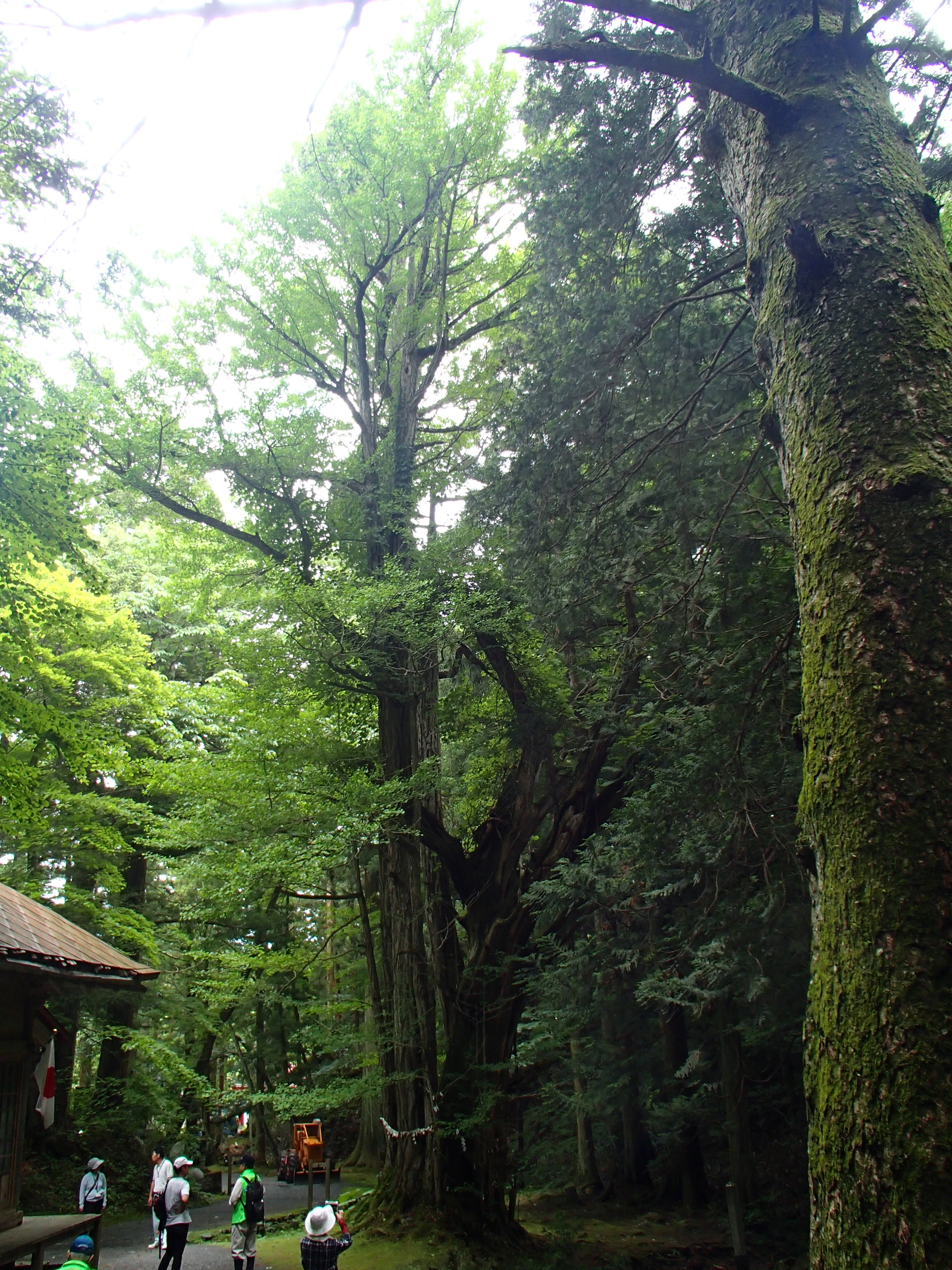潮山神社の銀杏(Ushioyama Shrine Ginkgo biloba)
推定樹齢(Estimated Age) 800年(years)
幹周合計(Circumference) 10.10m
樹高(Height) 23.00m
潮山神社境内は、この銀杏、モミ、参道のスギ並木が見事です。またトチ、カツラ、サワグルミなど沢に多い樹木がみられます。イワナもいる渓流が参道脇に流れていて、夏にはヒメボタルの乱舞が見られます。
鬱蒼とした巨木に囲まれ清らかな流れのあるこの地を訪れるたび、心までが和んでいくのは自然と融合した理想の世界があるからではないでしょうか。
Ushioyama Shrine and the Giant Ginkgo biloba
The grounds of Ushioyama Shrine are home to a variety of lovely trees. Along with this ginko biloba, you will find a large Japanese fir, and rows of Japanese cedars lining the shrine path. Japanese horse chestnut, Japanese wing nut, and katsura are also represented. Char swim in the mountain stream that flows alongside the path, and in summertime fireflies dance in the twilight.
Ushioyama Jinja Shrine is dedicated to Futsunushi no Mikoto, the Shinto deity of swords. The Kannon statue now housed at nearby Terashita Kannon Temple was originally located here, before its removal when Buddhism and Shintoism were separated by government mandate in the Meiji era (1868–1912). An enormous ginkgo tree (Ginkgo biloba) stands in the shrine precincts. In autumn the tree’s leaves turn bright yellow, and create a “golden carpet” around the shrine when they fall.
The stone pillar near the shrine sanctuary is a kyozuka, or sutra mound, erected by Settai Soseki, a retainer of the lord of Hachinohe, to bring peace to the dead and prosperity to the living. Underneath the pillar are stones painted with different Chinese characters from Buddhist sutras. Fifteen such monuments have been found in the area.
Inside the pavilion-like structure next to the nearby stream is a pool of water used in a fortune-telling ritual. Believers place a coin on top of a piece of paper and make a wish as they float it on the water’s surface. If the paper sinks, it is thought that the wish will come true.
The path beyond Ushioyama Jinja heads uphill past the former site of a five-tiered pagoda to Tomyodo Temple at the top of the hill.
<簡体字>
潮山神社
潮山神社是神道教剑神“经津主神”的祭祠。明治时代(1868-1912)政府下令神佛分离后,原本供奉于此的观音像已经移至附近的寺庙“寺下观音”。神社内矗立着一棵巨大的银杏(Ginkgo biloba),秋天树叶转成明黄色,飘落之际,整个神社都如同铺上了金色地毯。
神社本殿(主殿)旁的石塔是一座“经冢”,它是八户藩领主的家臣“接待宗硕”为祭奠死者、祈求生者繁荣而立。经冢下的石块上都刻有汉字佛经。该地区已经发现了15座这样的经冢。
溪水旁的亭式建筑是“寄场”(会所),里面有一汪可以占卜吉凶的水潭。占卜者只要将一枚硬币置于一张纸上,将纸放在水面上并许下心愿。如果纸沉了,就意味着能称心如意。
沿着潮山神社外的坡道一路往上,途径五重塔遗迹后,最终可以到达山顶的灯明堂。
<繁体字>
潮山神社
潮山神社是神道教劍神「經津主神」的祭祠。明治時代(1868-1912)政府下令神佛分離後,原本供奉於此的觀音像被移至鄰近的寺廟「寺下觀音」。神社內矗立著一棵巨大的銀杏(Ginkgo biloba),秋天樹葉轉成明黃色,飄落之際,整個神社都如同鋪上了金色地毯。
神社本殿(主殿)旁的石塔是一座「經塚」,它是八戶藩領主的家臣「接待宗碩」建造,為祭奠死者、祈求生者繁榮而立。經塚下的石塊上都刻有漢字佛經。該地區已經發現了15座這樣的經塚。
溪水旁的亭式建築是「寄場」(會所),裡面有一個水潭可以占卜吉凶。占卜者只要將一枚硬幣置於一張紙上,將紙放在水面上並許下心願。如果紙沉了,就意味著能心想事成。
沿著潮山神社外的坡道一路往上,途徑五重塔遺跡後,最終可到達山頂的燈明堂。

地域観光資源の多言語解説整備支援事業




